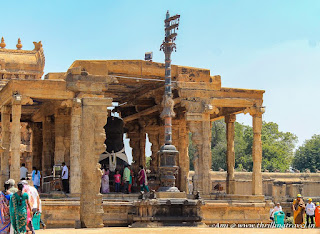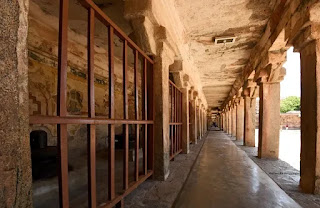A couple of days ago I went past the Big temple, Thanjavur around 9.45 am and it was unusually over crowded and the huge parking lot across the temple, abetting RM Hospital was getting filled up with all kinds of motor vehicles, vans and buses. Upon enquiry I realized in the wake of the recent release of the film ''Ponniyin Selvan'' (by the popular novelist late Kalki) directed by famous film director Mani Ratnam the popular and awe-inspiring great living Chola temple got more attention among the tourists. Now, it is hogging more limelight than ever before. The director successfully filmed the first part of the movie despite odds like Covid -9 pandemic threats, highlighted a lengthy story about the Chola family members and their internal turmoil, etc., in a 2-hour time capsule and thirdly his cast included well-known film stars donning different roles in the movie.
Yet another curiosity is much has been written about Tamil Nadu politicians' in the school text books but not so much about Tamil rulers of past era. The frequent question asked by the people is why the school text books do not include details about the great Chola kings and their war exploits, etc.
Now the great Chola ruler is in the center of a storm over his religious affiliation and it was raised by none other than actor and politician Kamal Hassan. His off the cuff remarks sometimes create controversies. A few years ago he faced a barrage of criticism when he branded Gandhiji's assassin Naturam Godse as a Hindu terrorist (his killing of Gandhiji is not justified, but he was not a terrorist, according to many critics). Though Chola rulers were ardent followers of God Shiva, they did patronize lots of Vishnu temples. Obviously they were Hindus (though the term Hindu was not is use 1000 years ago) but it is obvious that Shaivism is part of Hinduism. As a matter of fact there are stone images of Sri Krishna and Sri Vishnu on the gopuras of the big temple.
These above latest sensational events made the people become more curious and the number of people visiting the big temple may increase manifold in the future.
The following are the amazing facts of Thanjai Big temple:
01. Called Thanjai Periya kovil or Brihadishvara Temple in common parlance, the original name was Rajarajeshwaram (meaning temple of the almighty of Rajaraja"). Tamil scholars call it Peruvudaiyar Kovil dedicated to God Shiva. The builder was Great King Raja Raja Chola (985 -1012 A.D) who was also known as Sivapada Sundaran meaning a man devoted to the holy feet of Shiva. Temple inscription says ''he first placed all the spoils of war at the feet of god and sought blessing from the almighty."
 |
| vintage image. Tanjore big temple, TN.21clicks.com |
 |
| Shakti worship, Durga Devi, big temple. in.pinterest.com |
02. The 216- foot tall Shikara is entirely made of granite and gneissic rocks of Archaeon age (the oldest rocks on earth more than three billion years old). They were mined 50km from here.

Big temple Hard rocks with holes for splitting. quora.com
Above image: Thanjavur Brihadeeswara temple. Blocks of hard rocks were sized, using partial controlled explosions and then transported to the temple sites, using trained elephants. Further sizing was done by drilling several holes in the rock ad per needs and then filling up them with water. After the waiting period rocks will break This method followed called here is 'rock weathering' and the principle is alternating freezing and thawing of water will weaken the rocks and facilitate breaking..........
03. A temple of grandeur and beauty, it is the first Hindu temple in India to have been built on such a grand scale." At that point of time it was 40 times bigger than other temples. The architect and engineer of the temple was one "Kunjara Mallan Raja Raja Rama Perunthachan.
04. The vimana, symbolic of the sacred abode of God Shiva - holy Meru (Mount Kailash) goes by the name of Dakshina (south) Meru, and the Lord was referred to as as Dakshina Meru Vitankar.
05. The richly ornate large cupola with symmetrical images on all sides and the square granite platform atop the tower weigh roughly 80 tones; their erection at such a height is an unsolved puzzle,
 |
| Nandi facing the main shrine. flag pole in the front. thrillingtravel.in |
Above image: Thanjavur Big temple, Dwajasthambam and the nadi mantapam. Nandi is facing the main deity Shiva. The myth that the nandi grew large in size because of a live toad inside the stone is not true. It is mere figment of somebody's imagination..........
.jpg) |
| Monolithic nandi, Thanjai Big temple. thrillingtravel.in |
 |
| Top of Thanjai big temple. upload.wikimedia.org |
 |
| Thanjavur big temple cupola. thrillingtravel.in |
.jpg) |
| Interior hollow tower above sanctum. haribhakt.com |
07. Unlike other gopura, this one has a hollow space inside up to the top. The ingenious designers built the hollow tower by using interlocking stones without using any binding material.
08. Thanjai Periya kovil is a rare one to have a tall tower above the garbagriha - something like the Nagara style. In most temple in Tamil Nadu the gopuram over the karuvarai- sanctum is a small one.
 |
| Thanjavur big temple, Rajarajan Tiruvasal thrillingtravel.in |
 |
| Keralatakan Gopuram Thanjavur big temple,thrillingtravel.in |
 |
| old image. Brihadeeswara temple, Thanjavur in.pinterest.com |
 |
| Thanjavur big temple, TN in.pinterest.com |
10. The temple houses the the images of guardian angels Ashtadikpaalakas covering both cardinal and ordinal directions and they are Indra, Agni, Nirrti, Varuna, Kubera, Isana, Yama, and Vayu.
11. There are images of Vishnu, Sri Krishna, Kali and Durga suggesting Shaivaism, Vaishnavism and Shaktism were part of the Hindu religion.
 |
| tallest Shiva Linga, Big temple, Thanjavur templefolks.com |
Above image: Big temple, Thanjavur. One of the Tallest Shiva Lingas in India and is enshrined in the middle of the garbagriha-sanctum which is roughly more than two floors tall. Above the sanctum, one can see the hollow space of the tall tower/gopura.
 |
| ront part of nandi mantap, Thanjai Big temple, TN in.pinterest.com |
 |
| Thanjavur big temple. outer prakara. linags on right. mapinmypocket.com/ |
 |
| Lingas in the corridor, big temple Thanjavur, Alamy.com |
 |
| 108 lingams in a small mantap Tanjore Temple hrillingtravel.in |
 |
| Sri Nataraja (Shiva) and his cosmic dance. upload.wikimedia.or |
13. The temple is also famed for the beautifully sculpted stone images of earliest and largest illustration of dance movements and postures (mudras), as described in the Natya Shastra. They are on the upper story corridor wall of the aditala and there are 81 of the 108 dance karanas – postures of Natya Sastra. The 27 karanas are blank for unknown reasons. This suggests classical Indian dance form developed in the 11th century in this part of south India.
14. There are countless well- chiseled sculptures, inscriptions and frescoes on the gopuras, the main massive tower, etc., mostly related to Shaivism, but also of Vaishnavism and Shaktism traditions of Hinduism.
 |
| water spout - pranala (outlet) big temple, Thanjavur. upload.wikimedia.org |
 |
| water spout (outlet) big temple, Thanjavur.upload.wikimedia.org |
 |
| stone carved water tank. thrillingtravel.in |
 |
| Subramanya shrine. Tanjore Temple thrillingtravel.in |
Above image: God Subramanya shrine. All along the outer ornate wall a small stone horizontal ornamental projection has innumerable small holes through which a small needle could pass through. Unfortunately a few of the fine images in the porch of the shrine are damaged due to vandalism. This shrine came up in the later period during the reign of the Tanjore Nayaks.......

.jpg)










